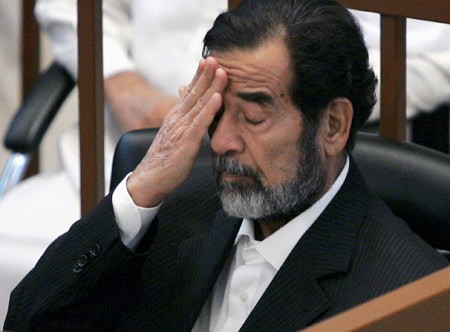Saddam buried in native village
(Reuters)Updated: 2006-12-30 11:23
Human Rights Watch criticized the execution, calling Saddam's trial "deeply flawed."
"Saddam Hussein was responsible for massive human rights violations, but that can't justify giving him the death penalty, which is a cruel and inhuman punishment," said Richard Dicker, director of Human Rights Watch's International Justice Program.
|
"The Americans want him to be hanged respectfully.If Saddam is humiliated publicly or his corpse ill-treated,that could cause an uprising and the Americans would be blamed." Najeeb al-Nueimi A member of Saddam's legal team |
The hanging of Saddam, who was ruthless in ordering executions of his opponents, will keep other Iraqis from pursuing justice against the ousted leader.
At his death, he was in the midst of a second trial, charged with genocide and other crimes for a 1987-88 military crackdown that killed an estimated 180,000 Kurds in northern Iraq. Experts said the trial of his co-defendants was likely to continue despite his execution.
Many people in Iraq's Shiite majority were eager to see the execution of a man whose Sunni Arab-dominated regime oppressed them and Kurds.
Before the hanging, a mosque preacher in the Shiite holy city of Najaf on Friday called Saddam's execution "God's gift to Iraqis."
"Oh, God, you know what Saddam has done! He killed millions of Iraqis in prisons, in wars with neighboring countries and he is responsible for mass graves. Oh God, we ask you to take revenge on Saddam," said Sheik Sadralddin al-Qubanji, a member of the Supreme Council for the Islamic Revolution in Iraq.
|
|
On Thursday, two half brothers visited Saddam in his cell, a member of the former dictator's defense team, Badee Izzat Aref, told The Associated Press by telephone from the United Arab Emirates. He said the former dictator handed them his personal belongings.
A senior official at the Iraqi defense ministry said Saddam gave his will to one of his half brothers. The official spoke on condition of anonymity because he was not authorized to speak to the media.
In a farewell message to Iraqis posted Wednesday on the Internet, Saddam said he was giving his life for his country as part of the struggle against the US "Here, I offer my soul to God as a sacrifice, and if he wants, he will send it to heaven with the martyrs," he said.
One of Saddam's lawyers, Issam Ghazzawi, said the letter was written by Saddam on Nov. 5, the day he was convicted by an Iraqi tribunal in the Dujail killings.
The message called on Iraqis to put aside the sectarian hatred that has bloodied their nation for a year and voiced support for the Sunni Arab-dominated insurgency against US-led forces, saying: "Long live jihad and the mujahedeen."
Saddam urged Iraqis to rely on God's help in fighting "against the unjust nations" that ousted his regime.
Najeeb al-Nauimi, a member of Saddam's legal team, said US authorities maintained physical custody of Saddam until the execution to prevent him being humiliated publicly or his corpse being mutilated, as has happened to previous Iraqi leaders deposed by force. He said they didn't want anything to happen to further inflame Sunni Arabs.
"This is the end of an era in Iraq," al-Nauimi said from Doha, Qatar. "The Baath regime ruled for 35 years. Saddam was vice president or president of Iraq during those years. For Iraqis, he will be very well remembered. Like a martyr, he died for the sake of his country."
Iraq's death penalty was suspended by the US military after it toppled Saddam in 2003, but the new Iraqi government reinstated it two years later, saying executions would deter criminals.
Saddam's own regime used executions and extrajudicial killings as a tool of political repression, both to eliminate real or suspected political opponents and to maintain a reign of terror.
In the months after he seized power on July 16, 1979, he had hundreds of members of his own party and army officers slain. In 1996, he ordered the slaying of two sons-in-law who had defected to Jordan but returned to Baghdad after receiving guarantees of safety.
Saddam built Iraq into a one of the Arab world's most modern societies, but then plunged the country into an eight-year war with neighboring Iran that killed hundreds of thousands of people on both sides and wrecked Iraq's economy.
During that war, as part of the wider campaign against Kurds, the Iraqi military used chemical weapons against the Kurdish town of Halabja in northern Iraq, killing an estimated 5,000 civilians.
The economic troubles from the Iran war led Saddam to invade Kuwait in the summer of 1990, seeking to grab its oil wealth, but a US-led coalition inflicted a stinging defeat on the Iraq army and freed the Kuwaitis.
UN sanctions imposed over the Kuwait invasion remained in place when Saddam failed to cooperate fully in international efforts to ensure his programs for creating weapons of mass destruction had been dismantled. Iraqis, once among the region's most prosperous, were impoverished.
The final blow came when US-led troops invaded in March 2003. Saddam's regime fell quickly, but political, sectarian and criminal violence have created chaos that has undermined efforts to rebuild Iraq's ruined economy.
While he wielded a heavy hand to maintain control, Saddam also sought to win public support with a personality cult that pervaded Iraqi society. Thousands of portraits, posters, statues and murals were erected in his honor all over Iraq. His face could be seen on the sides of office buildings, schools, airports and shops and on Iraq's currency.
 | 1 | 2 | 3 | 4 | 5 | 6 | 7 |  |
|
||
|
||
|
|
